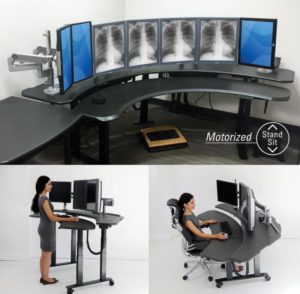Choosing the right radiology workstation is a critical decision that can significantly impact a radiologist’s efficiency and accuracy. The diverse range of products available on the market necessitates a thoughtful evaluation of various factors, including display quality, performance, compliance, and ergonomics. Integrating advanced software and considering interface design can further enhance the interpretation process. By carefully considering these critical elements, radiologists can select a workstation that optimizes their performance, promotes accurate diagnoses, and positively impacts patient outcomes.
Critical Elements of a Radiology Workstation
 Display Quality and Resolution: A high-resolution display is paramount for accurate radiological image interpretation. Workstations with high-definition and calibrated monitors ensure that radiologists can discern fine details and subtle differences in grayscale levels.
Display Quality and Resolution: A high-resolution display is paramount for accurate radiological image interpretation. Workstations with high-definition and calibrated monitors ensure that radiologists can discern fine details and subtle differences in grayscale levels.
GPU and CPU Performance: Powerful GPUs and CPUs are vital for handling the complex computations and image rendering required in radiology. A workstation equipped with advanced processors can enhance speed and efficiency in image manipulation and analysis.
DICOM Compliance: Ensuring that the workstation adheres to Digital Imaging and Communications in Medicine (DICOM) standards is essential for seamless integration with PACS and other imaging systems. DICOM compliance ensures consistent and accurate transfer, storage, and display of medical images.
Multi-Modality Support: A versatile workstation should support various imaging modalities, including X-ray, CT scans, MRI, ultrasound, and more. This ensures that radiologists can work with different types of medical images on the same platform.
Ergonomic Design: Comfort is critical during prolonged interpreting sessions. An ergonomically designed workstation with adjustable monitor height, viewing angles, and keyboard positioning reduces strain and fatigue, promoting better focus and productivity.
Network and Security Features: A secure network connection and robust data encryption are essential for safeguarding patient data and maintaining HIPAA compliance.
Software Integration: Seamless integration with advanced image analysis and post-processing software allows radiologists to efficiently manipulate and analyze images, leading to more accurate diagnoses.
FDA and CE Mark Approval: Ensuring that the workstation is FDA-approved and carries a CE mark is vital for compliance with international medical device regulations.
Support and Maintenance: Timely support and maintenance services are crucial for addressing technical issues promptly and minimizing downtime.
Considering Hardware and Software Aspects
Interface Design: The interface should be intuitive and user-friendly, enabling radiologists to navigate the workstation efficiently. Customizable layouts and shortcuts can enhance workflow and streamline the interpretation process.
Image Manipulation Tools: Advanced tools for zooming, panning, window leveling, and measuring should be available, allowing radiologists to examine images comprehensively.
examine images comprehensively.
Hanging Protocols: Workstations with customizable hanging protocols enable radiologists to arrange and compare images based on their preferences and clinical requirements.
3D Visualization: Workstations with 3D visualization capabilities allow radiologists to reconstruct and analyze volumetric images, offering valuable insights for complex cases.

